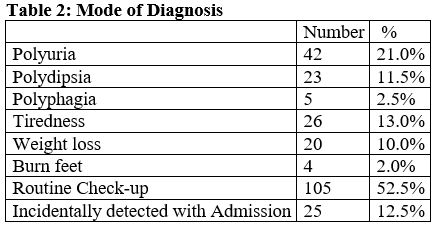A Cross-Sectional Study of Socio-Demographic and Clinical Features of Indian Subjects with Type 2 Diabetes Mellitus in a Tertiary Diabetes Hospital
Abstract
Introduction: Diabetes mellitus is a group of heterogeneous diseases with varied clinical presentation and disease progression. Understanding the socio-demographic factors in subjects with diabetes is an important step for planning diabetes care. Objectives: The objective of the study was to assess the socio-demographic and clinical features of subjects with diabetes and impact of these factors on their glycemic control. Materials and Methods: A cross-sectional observational study was conducted in the outpatient department of Karnataka Institute of Endocrinology and research, Bangalore. 200 subjects with diabetes were recruited for the study, between January to August 2019. Results: In the study, mean age at diagnosis was 43.73 ± 8.705 years. Majority of subjects were in the age group >56 years (53%). 59.5% of the subjects were males and 83.5% of the subjects were from urban area. Majority of them were diagnosed during routine check-up (52.5%). Most common symptom was polyuria (21%). 12.5% of the subjects were incidentally detected during hospital admission. 46.5% had family history of Diabetes. 77.5% of the subjects were overweight and obese. Only 18.5% of the subjects had HbA1c <7. 39% of the subjects had dyslipidemia, 54.5% had hypertension and 19% had hypothyroidism. 29% of the subjects had retinopathy, 20% had neuropathy, 7% had nephropathy and 3.5% had PAD. 79% of the subjects were on OHA, 6% were on insulin and 12.5% were on both OHA and insulin. Amongst the subjects on oral drugs, only 6.3% were on monotherapy and the rest were on multiple drugs. Amongst subjects on insulin, 96.5% were on premixed insulin. Age, gender, education, OHA and combination of insulin and OHA for treatment were the factors associated significantly with glycemic control. Good control was highest in young age group (66.7%) and lowest in old age group (16%). Females had highest level of poor control compared to males. Graduates had higher percentage of good control compared to lower educational status. Subjects on OHA had higher percentage of good control. Conclusions: The study revealed that poor glycemic control, comorbidities like HTN, obesity and dyslipidemia and chronic complications were commonly prevalent in subjects with T2DM. Emphasis should be given to periodic evaluation of glycemic status, comorbidities, and diabetes complications.
Downloads
References
2. International Diabetes Federation. IDF Diabetes Atlas, 10th edn. Brussels, Belgium: International Diabetes Federation, 2021.
3. Heng, Bee Hoon, et al. "The Singapore national healthcare group diabetes registry—Descriptive epidemiology of type 2 diabetes mellitus." Annals Academy of Medicine Singapore 39.5 (2010): 348.
4. Davies, Melanie J et al. "Management of hyperglycemia in type 2 diabetes, 2022. A consensus report by the American Diabetes Association (ADA) and the European Association for the Study of Diabetes (EASD)." Diabetes care 45.11 (2022): 2753-2786.
5. Borah M, Goswami RK. Sociodemographic and clinical characteristics of a diabetic population at a tertiary care center in Assam, India. J Soc Health Diabetes 2017; 5:37-42.
6. Petry NM. A comparison of young, middle-aged, and older adult treatment-seeking pathological gamblers. Gerontologist. 2002 Feb; 42(1):92-9.
7. World Health Organization (WHO). International Association for the Study of Obesity (IASO) and International Obesity Task Force (IOTF). The Asia-Pacific Perspective: Redefining Obesity and its Treatment. Geneva: World Health Organization; 2000. p. 378-420.
8. Dakhale GN, Hiware SK, Shinde AT, Mahatme MS. Basic biostatistics for post-graduate students. Indian J Pharmacol. 2012; 44(4):435-442.
9. Sunder Rao P S S, Richard J: An Introduction to Biostatistics, A manual for students in health sciences, New Delhi: Prentice Hall of India. 4th edition. 2006; 86-160.
10. Elenbaas, RM, Elenbaas, JK, Cuddy, PG. Evaluating the medical literature, part II: Statistical analysis. Ann Emerg Med. 1983; 12:610–620.
11. Chaudhary GMD, Chaudhary FMD, Tanveer A, Tameez Ud Din A, Chaudhary SMD, Tameez Ud Din A, Shafi A. Demographic and Clinical Characteristics of 4556 Type 2 Diabetes Mellitus Patients at a Tertiary Care Hospital in Southern Punjab. Cureus. 2019 May 3; 11(5):e4592. doi: 10.7759/cureus.4592. PMID: 31309017; PMCID: PMC6609286.
12. Palacios MS, Vernet MV, Sáez PL, Figueras ET, Sala MF. Socio-demographic and clinical characteristics of a patient population with diabetes mellitus. Atención Primaria. 2002 Jan 1; 29(8):474-80.

Copyright (c) 2023 Author (s). Published by Siddharth Health Research and Social Welfare Society

This work is licensed under a Creative Commons Attribution 4.0 International License.


 OAI - Open Archives Initiative
OAI - Open Archives Initiative


